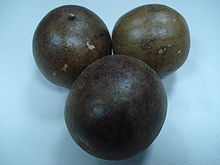
Siraitia grosvenorii

Siraitia grosvenorii (monk fruit or luo han guo) is a herbaceous perennial vine of the Cucurbitaceae (gourd) family, native to southern China and northern Thailand. The plant is cultivated for its fruit, whose extract is nearly 300 times sweeter than sugar and has been used in China as a low-calorie sweetener for cooling drinks and in traditional Chinese medicine. The plant's fruit is often called in English language publications luo han guo or lo han kuo (from the Chinese luóhàn guǒ, 罗汉果/羅漢果). The scientific species name honors Gilbert Hovey Grosvenor, who as president of the National Geographic Society, helped to fund an expedition in the 1930s to find the living plant in China where it was being cultivated. The fruit was first mentioned in the records of 13th-century Chinese monks in Guangxi in the region of Guilin. The difficulty of cultivation meant the fruit did not become part of the Chinese herbal tradition which depended on more readily available products. Luóhàn (羅漢) is a shortened form of āluóhàn (Chinese: 阿羅漢), which is an old transliteration of the Indian Sanskrit word arhat (prakrit: arahant). In early Buddhist traditions, a monk who becomes enlightened is called an arhat who attains the 'fruition of arhatship' (Sanskrit: arhattaphala). This was rendered in Chinese as luóhàn guǒ (羅漢果 literally 'arhat fruit') which later became the Chinese and western commercial designation for this type of sweet fruit. It may also be called la han qua (from Vietnamese la hán quả), Buddha fruit, or longevity fruit (also used for other fruits). The first report in England on the herb was found in an unpublished manuscript written in 1938 by G. Weidman Groff and Hoh Hin Cheung. The report stated the fruits were often used as the main ingredients of 'cooling drinks' as remedies for hot weather, fever, or other dysfunctions traditionally associated with warmth or heat (i.e., inflammation). The fruit was taken to the United States in the early 20th century. Groff mentioned that, during a visit to the American ministry of agriculture in 1917, the botanist Frederick Coville showed him a luo han guo fruit bought in a Chinese shop in Washington, DC. Seeds of the fruit, which had been bought in a Chinese shop in San Francisco, were entered into the botanic description of the species in 1941.
